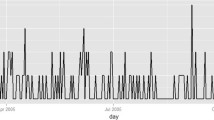Abstract
We developed a space–time prospective surveillance method when the data are point events, monitoring if there is an emerging cluster. Typical application areas are crime or disease surveillance. At each new event, a local Knox score is calculated and spatially spread to form a stochastic surface. The surfaces are accumulated sequentially until they exceed a specified threshold, causing an alarm to go off and identify the region of the probable cluster. The method requires little prior knowledge from the user and provides a way to identify locations and time of possible clusters, through the visualization of the cumulative surface. We present a simulation study for different cluster scenarios, as well as an application to a dataset of meningitis cases in Belo Horizonte, Brazil.













Similar content being viewed by others
References
Abrams AM, Kleinman K, Kulldorff M (2010) Gumbel based p-value approximations for spatial scan statistics. Int J Health Geogr 9(1):61
Assunção R, Correa T (2009) Surveillance to detect emerging space–time clusters. Comput Stat Data Anal 53(8):2817–2830
Diggle P, Rowlingson B, Su T (2005) Point process methodology for on-line spatio-temporal disease surveillance. Environmetrics 16(5):423–434
Fricker RD, Chang JT (2008) A spatio-temporal methodology for real-time biosurveillance. Quality Eng 20(4):465–477. doi:10.1080/08982110802334096
Höhle M (2007) “surveillance:” An R package for the monitoring of infectious diseases. Comput Stat 22(4):571–582
Jacquez GM (1996) A k nearest neighbour test for space–time interaction. Stat Med 15(18):1935–1949
Knox EG (1964) The detection of space–time interactions. J R Stat Soc Ser C (Applied Statistics) 13(1):25–30
Kulldorff M (1999) The Knox method and other tests for space–time interaction. Biometrics 55(2):544–552
Kulldorff M (2001) Prospective time periodic geographical disease surveillance using a scan statistic. J R Stat Soc A 164(1):61–72
Kulldorff M, Heffernan R, Hartman J, Assunção R, Mostashari F (2005) A space–time permutation scan statistic for disease outbreak detection. PLoS Med 2(3):e59
Lewis PAW, Shedler GS (1979) Simulation of nonhomogeneous poisson processes by thinning. Nav Res Logist Q 26(3):403–413
Mantel N (1967) The detection of disease clustering and a generalized regression approach. Cancer Res 27(2):209–220
Marshall JB, Spitzner DJ, Woodall WH (2007) Use of the local Knox statistic for the prospective monitoring of disease occurrences in space and time. Stat Med 26(7):1579–1593
Neill DB, Moore AW, Sabhnani M, Daniel K (2005) Detection of emerging space–time clusters. In: KDD ’05: Proceedings of the eleventh ACM SIGKDD international conference on knowledge discovery in data mining, pp 218–227.
Piroutek A, Assunção R, Paiva T (2014) Space–time prospective surveillance based on knox local statistics. Stat Med 33(16):2758–2773. doi:10.1002/sim.6118
Piterbarg VI (1996) Asymptotic methods in the theory of Gaussian processes and fields. AMS translations of mathematical monographs, vol 148. Providence, RI
Robertson C, Nelson TA, MacNab YC, Lawson AB (2010) Review of methods for space–time disease surveillance. Spat Spatio-temporal Epidemiol 1(2):105–116
Rodeiro C, Lawson A (2006) Monitoring changes in spatio-temporal maps of disease. Biomet J 48(3):463–480
Rogerson PA (2001) Monitoring point patterns for the development of space–time clusters. J R Stat Soc A 164(1):87–96
Rue H, Held L (2005) Gaussian Markov random fields: theory and applications. Monographs on statistics and applied probability, vol 104. CRC Press
Simões TC, Assunção RM (2005) Sistema de vigilância para detecção de interações espaço-tempo de eventos pontuais. In: GEOINFO 2005 - VII Simpósio Brasileiro de Geoinformática, pp 281–291
Sonesson C, Bock D (2003) A review and discussion of prospective statistical surveillance in public health. J R Stat Soc A 166(1):5–21
Unkel S, Farrington CP, Garthwaite PH, Robertson C, Andrews N (2012) Statistical methods for the prospective detection of infectious disease outbreaks: a review. J R Stat Soc Ser A (Statistics in Society) 175(1):49–82
Woodall WH, Marshall JB, Joner MD Jr, Fraker SE, Abdel-Salam AG (2008) On the use and evaluation of prospective scan methods in health-related surveillance. J R Stat Soc Ser A 171(1):223–237
Author information
Authors and Affiliations
Corresponding author
Rights and permissions
About this article
Cite this article
Paiva, T., Assunção, R. & Simões, T. Prospective space–time surveillance with cumulative surfaces for geographical identification of the emerging cluster. Comput Stat 30, 419–440 (2015). https://doi.org/10.1007/s00180-014-0541-y
Received:
Accepted:
Published:
Issue Date:
DOI: https://doi.org/10.1007/s00180-014-0541-y




